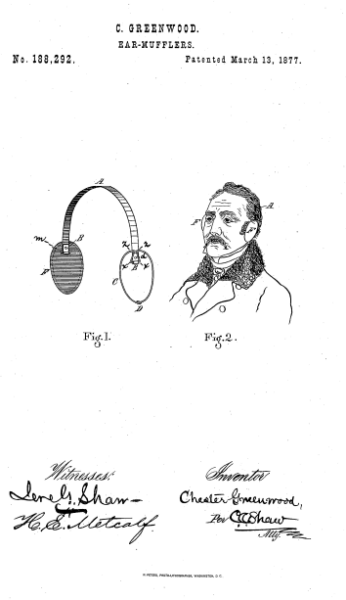By Janice Lindsay, Contributing Writer

Earmuffs. This month formally marks 145 years since the earmuff as we know it was invented.
The story goes that 15-year-old Chester Greenwood of Farmington, Maine, grew tired of having cold ears while he was ice skating. He could wrap his wool scarf around his head, but it was itchy and bulky. He bent some wires to the correct springy shape and asked his grandmother to sew fabric to the crucial spots. On March 13, 1877, he was granted a patent for what he called “improvement in ear-mufflers.”

Photo/Courtesy of the United States Patent and Trademark Office
Because his invention was labeled an “improvement” I suppose that earmuffs of some sort were already in use, but his were better, and people have been wearing them ever since. Earmuffs might go in and out of fashion, but they never go away. A quick internet search shows that you can buy a warm-looking pair of earmuffs for around $15, or you can go all designer-crazy and buy gray fox fur muffs, with crystal, for $350, which would probably scandalize Mr. Greenwood because, being a New Englander, he would think this was a waste of a good $335.
Chester Greenwood’s inventiveness demonstrates the ingenuity that can result from being cold – not to mention the kindness, helpfulness, and patience of grandmothers, but that’s another story.
Clothes, for example. I’m pretty sure clothes – at least, serious clothes — were invented by cold people. In tropical climates, people do not need clothes. If you travel to an equatorial getaway, you will pack clothes because that’s the convention. But you will not really need them to maintain your desired level of comfortable body temperature.
One of my favorite cold-weather inventions – after central heating – is the airplane. That’s because you can hop on an airplane (except the security people probably won’t allow you to hop, they will pull you aside for suspicious behavior) – that is, you could “board an aircraft” in the frigid north and hop off – that is, “deplane” — in some sunny, cozy climate.
I have done that because I have visited my dear Philadelphia friend at her winter place in Fort Lauderdale, Florida, which is almost as far south as you can travel and still be on the continental east coast of the U. S. of A.
I can attest that any cold-weather ingenuity you might possess in a New England winter evaporates into warm vapors when you find yourself lounging in the hot sun, reading a novel, wearing your t-shirt and shorts even though you don’t really need them but being clothed is the convention. You realize it’s a good thing that you bought a return ticket and feel obliged to use it, because you could easily stay there in the sun and turn into a warm blob of laziness and languor with no ingenuity at all.
One day, my friends and I visited the Everglades and rode an airboat. Floating lazily in the wooded waterways, we scanned the muddy banks for alligators. I happened to glance to the treetops where I spied swarms of dragonflies. I dearly love dragonflies. How many months would pass before my beloved dragonflies would venture to fly north to me? (Dragonflies, as I have observed, possess neither clothes nor earmuffs.)
That, of course, reminded me that I would, indeed, be coming home — home to the reality of winter – back to cold, back to snow, back to trying to exercise what little ingenuity I could muster, back to giving thanks for people like Chester Greenwood for whom cold is not merely a condition to be endured, but an inspiration for inventiveness.
Contact jlindsay@tidewater.net.
RELATED CONTENT:
Pondering fast summer, slow winter (fiftyplusadvocate.com)











